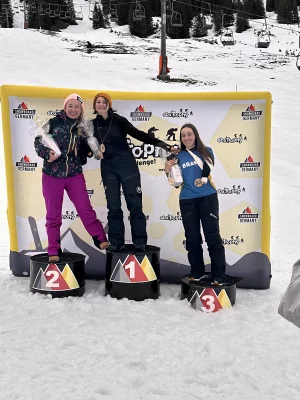
Adaptive Snowboarder Izy Hicks Carves Her Own Path
Action Sports
At just 22 years old, Izy Hicks is breaking barriers in adaptive sports as a competitive snowboarder. A congenital amputee competing in the Upper Limb I category, Hicks has made a name for herself in an environment where disabled women are often underrepresented, challenging misconceptions and inspiring people of all abilities to embrace their athletic potential.

Hicks began snowboarding at 10 years old and soon after became involved with the National Ability Center (NAC), a nonprofit based in Park City that promotes recreation for people with disabilities. She started racing competitively at age 13 in the boardercross event, where multiple riders race head-to-head down a course with turns, jumps and obstacles. Since then, Hicks has traveled to Canada, Italy, Germany and South Korea for adaptive snowboarding competitions and events. Despite her successes, the journey has not been without its challenges.
“There is a struggle to find people who validate adaptive sports as equal or unilaterally competitive with other able-bodied sports.”
One of Hicks’ most significant career moments came during her first international competition in Cortina, Italy where she suffered a bad fall and broke four ribs. Unaware of the extent of her injuries, she continued to race for two more days before finally getting an X-ray a week later. This kind of resilience is characteristic of Hicks and many disabled athletes in the sport.
Hicks describes the adaptive snowsports community as particularly close-knit and encouraging. “It’s about fostering a supportive environment that I think you don’t get in a lot of other sports,” she says. During one competition, Hicks had a nasty collision with another competitor, Polish adaptive snowboarder Anna Drobna. The two women developed a friendship afterward. “We were still thrilled to see each other later in competition. When people ask us who we want to win, we say each other,” says Hicks. The small field of competition has meant a close community for athletes, but it has also presented challenges for Hicks and other competitors.
“The adaptive environment, for snowboarding specifically, I’ve found to be really forthcoming in their support. They want people to show up, especially because [adaptive sports] are in peril of losing participation,” Hicks says. Women in particular are underrepresented in adaptive sports. “I think there are barriers in getting women involved, even about the attitudes surrounding women in sports,” she says. “I think a lot of times people don’t believe that’s even an option for them. It kind of turns a lot of women away automatically.”

Low participation on the women’s side has already put several adaptive snowboarding events in jeopardy, with one of the women’s categories being stripped from the Paralympic Games. Hicks’ category, Upper Limb I, has never been in the Paralympic Games at all. On the men’s side, the same category has the largest field of competition in Paralympic snowboarding. Hicks hopes to close the gaps in adaptive snowboarding, with one of her biggest goals being to grow the sport for women like her—sharing aspirations of starting a camp for disabled women to learn the fundamentals of freestyle riding. Hicks also hopes to join the national team one day, but her Paralympic aspirations are on hold until her category is introduced in the games.
“I think there are barriers in getting women involved, even about the attitudes surrounding women in sports.”
Despite the increased visibility of events like the Paralympics, many athletes still face misconceptions surrounding adaptive sports. “People with disabilities in adaptive sports do face a sort of infantilization. There is a struggle to find people who validate adaptive sports as equal or unilaterally competitive with other able-bodied sports,” Hicks says. Community support is crucial for adaptive sports, where local viewership and engagement can help nonprofits like the NAC thrive, increasing participation for future generations. Adaptive sports deserve the same levels of “social participation and celebration” as able-bodied sports, Hicks says, “because they really are just as hard, or harder, and just as fun, if not more fun, to watch.”
For interested viewers, follow along with Hicks’ season as she competes in boardercross and banked slalom events. Don’t miss the Huntsman Cup, an adaptive ski race and stepping stone to the Paralympics, hosted by the NAC in February to help build community support for adaptive sports.
Read more interviews with athletes here:
Building Strength & Confidence at the Highland Games
Community Through Kicks: Alexis Whitney’s SLC Muay Thai
